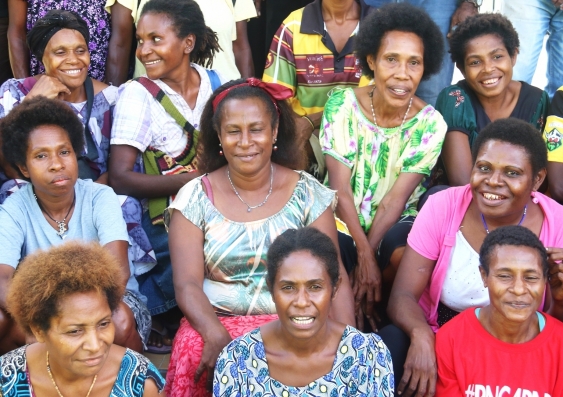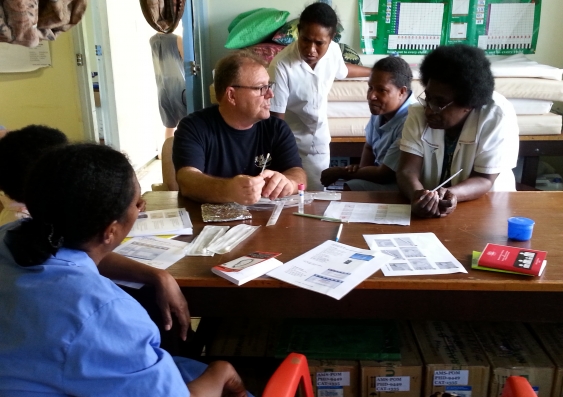Major collaboration aims to eliminate cervical cancer in the Western Pacific
Researchers at The Kirby Institute will collaborate on a first-of-its-kind program to set Papua New Guinea and Vanuatu on a path to eliminating cervical cancer.
Researchers at The Kirby Institute will collaborate on a first-of-its-kind program to set Papua New Guinea and Vanuatu on a path to eliminating cervical cancer.

Lucienne Bamford
The Kirby Institute UNSW Australia
+61 (0) 432 894 029
lbamford@kirby.unsw.edu.au
A landmark $8.1 million investment from the Minderoo Foundation will support researchers from The Kirby Institute at UNSW Sydney to co-lead a new cervical cancer elimination program in the Western Pacific.
The initiative is co-led by the Cancer Council NSW, the Kirby Institute, VCS Foundation, and Family Planning NSW on behalf of the NHMRC Centre of Research Excellence in Cervical Cancer Control (C4), in close collaboration with in-country partners and stakeholders.
The Western Pacific has among the highest rates of cervical cancer in the world, and there are an estimated 1200 deaths in Papua New Guinea (PNG) alone every year. Human papillomavirus, or HPV, causes almost all cervical cancers worldwide. HPV infection and disease can be prevented by childhood vaccination, whilst screening women for HPV infection in adult life is highly effective in detecting early disease and preventing cervical cancer.
Professor Andrew Vallely, who leads the Kirby Institute’s engagement in this initiative, welcomed the Minderoo Foundation’s investment.
“This first-of-its-kind humanitarian and research effort builds on more than a decade of collaborative research and partnership working in PNG and Vanuatu involving national and provincial health authorities, academic research institutes, medical societies and expert groups, consumer and patient advocates, and most importantly, women, their families and communities,” he said.
“Our role at the Kirby is to continue working closely with our in-country partners to ensure their incredible dedication, enthusiasm and commitment to cervical cancer prevention over many years is translated into lives saved now and, in the future.”
Caroline Henao is a cervical cancer survivor, patient advocate and Board Member of the Papua New Guinea Cancer Foundation. She says the new initiative will deliver real change in women’s lives.
'It will lead the world in putting the WHO Eliminate Cervical Cancer strategy into practice.'
“It would do so much in empowering women to have screening and to know that there is a way forward for them,” she said. “It would also encourage them to know this disease isn't a death sentence but very much curable if detected early.”
The World Health Organization (WHO) has set a target to eliminate cervical cancer as a public health problem globally by the end of the century. The program will set PNG and Vanuatu on a pathway to elimination by increasing the number of girls vaccinated against cervical cancer, providing access to cervical screening programs, and ensuring that women with cervical cancer and pre-cancer have access to effective and appropriate care.
The is expected to save the lives of 150,000 women in Papua New Guinea alone, Professor Karen Canfell, Director of Cancer Research at Cancer Council NSW says.
“It will lead the world in putting the WHO Eliminate Cervical Cancer strategy into practice, while creating a sustainable framework for attracting additional partners, and a catalyst for cervical cancer elimination globally,” Prof Canfell said.
The initiative will join forces with the Asia Development Bank, industry biotechnology partner Cepheid, and the Frazer Family Foundation, with in-kind contributions from the governments of PNG and Vanuatu, to provide almost $30 million.
Dr Steven Badman from the Kirby Institute played a key role in securing this donation in 2019.
“A major donation of HPV tests and equipment by Cepheid means we will be able to scale-up the point-of-care HPV testing and treatment services that we have pioneered over the last decade in the Pacific to reach all women aged 30–54 years in Western Highlands Province, PNG, and across the whole of Vanuatu,” he said.

Dr Steve Badman training health staff in point-of-care testing in Papua New Guinea.
The Eliminate Cervical Cancer in the Western Pacific program will advance the WHO strategy to eliminate cervical cancer as a public health problem globally by the end of the century, based on a ‘triple-intervention’ approach. It sets out simple targets to place all countries on the path toward elimination by 2030 – the so-called ’90-70-90’ targets.